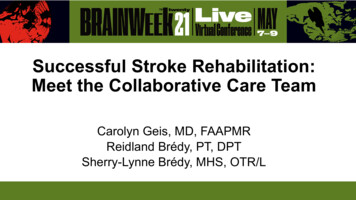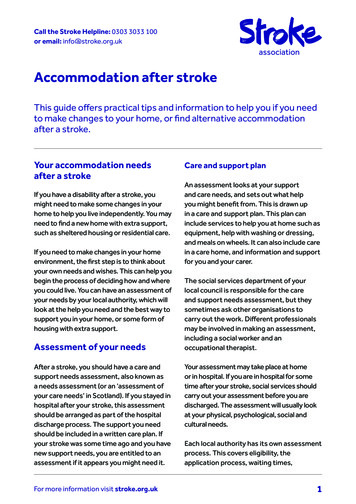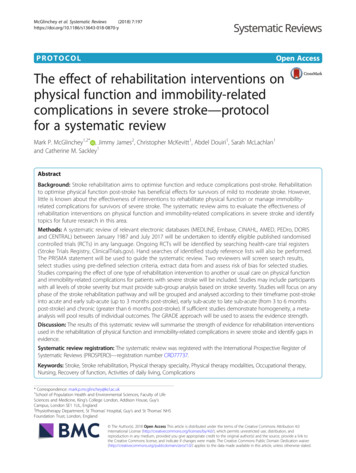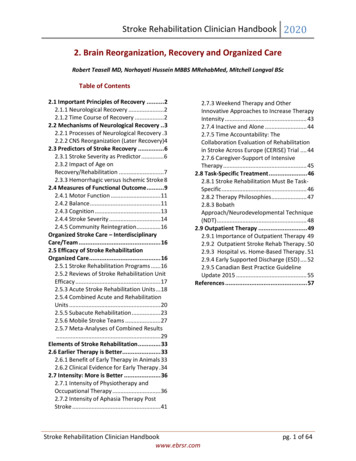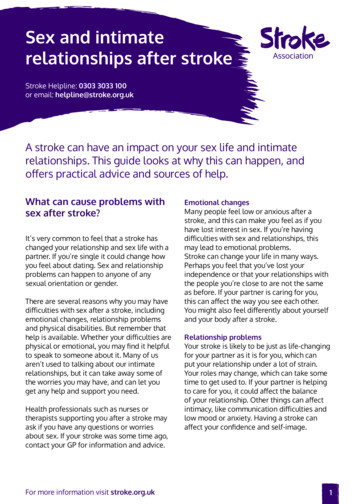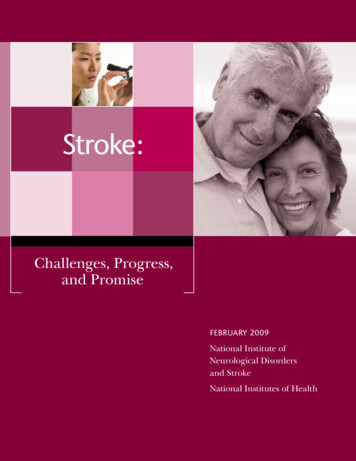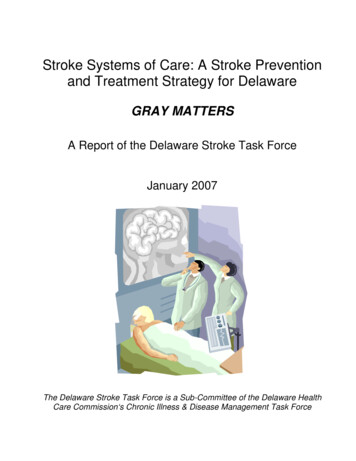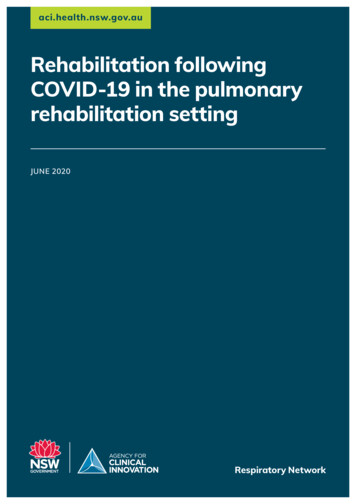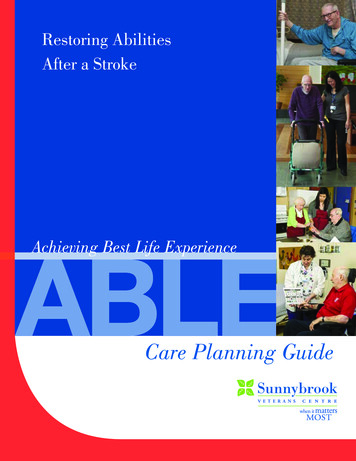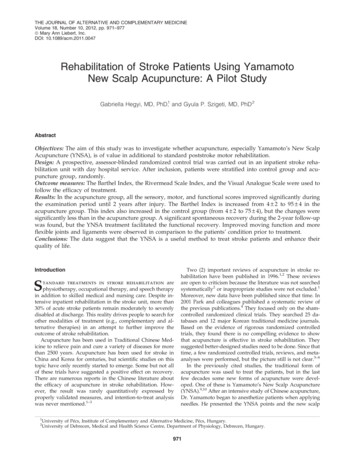
Transcription
THE JOURNAL OF ALTERNATIVE AND COMPLEMENTARY MEDICINEVolume 18, Number 10, 2012, pp. 971–977ª Mary Ann Liebert, Inc.DOI: 10.1089/acm.2011.0047Rehabilitation of Stroke Patients Using YamamotoNew Scalp Acupuncture: A Pilot StudyGabriella Hegyi, MD, PhD,1 and Gyula P. Szigeti, MD, PhD 2AbstractObjectives: The aim of this study was to investigate whether acupuncture, especially Yamamoto’s New ScalpAcupuncture (YNSA), is of value in additional to standard poststroke motor rehabilitation.Design: A prospective, assessor-blinded randomized control trial was carried out in an inpatient stroke rehabilitation unit with day hospital service. After inclusion, patients were stratified into control group and acupuncture group, randomly.Outcome measures: The Barthel Index, the Rivermead Scale Index, and the Visual Analogue Scale were used tofollow the efficacy of treatment.Results: In the acupuncture group, all the sensory, motor, and functional scores improved significantly duringthe examination period until 2 years after injury. The Barthel Index is increased from 4 – 2 to 95 – 4 in theacupuncture group. This index also increased in the control group (from 4 – 2 to 75 – 4), but the changes weresignificantly less than in the acupuncture group. A significant spontaneous recovery during the 2-year follow-upwas found, but the YNSA treatment facilitated the functional recovery. Improved moving function and moreflexible joints and ligaments were observed in comparison to the patients’ condition prior to treatment.Conclusions: The data suggest that the YNSA is a useful method to treat stroke patients and enhance theirquality of life.IntroductionStandard treatments in stroke rehabilitation arephysiotherapy, occupational therapy, and speech therapyin addition to skilled medical and nursing care. Despite intensive inpatient rehabilitation in the stroke unit, more than30% of acute stroke patients remain moderately to severelydisabled at discharge. This reality drives people to search forother modalities of treatment (e.g., complementary and alternative therapies) in an attempt to further improve theoutcome of stroke rehabilitation.Acupuncture has been used in Traditional Chinese Medicine to relieve pain and cure a variety of diseases for morethan 2500 years. Acupuncture has been used for stroke inChina and Korea for centuries, but scientific studies on thistopic have only recently started to emerge. Some but not allof these trials have suggested a positive effect on recovery.There are numerous reports in the Chinese literature aboutthe efficacy of acupuncture in stroke rehabilitation. However, the result was rarely quantitatively expressed byproperly validated measures, and intention-to-treat analysiswas never mentioned.1–3Two (2) important reviews of acupuncture in stroke rehabilitation have been published in 1996.1,2 These reviewsare open to criticism because the literature was not searchedsystematically2 or inappropriate studies were not excluded.1Moreover, new data have been published since that time. In2001 Park and colleagues published a systematic review ofthe previous publications.4 They focused only on the shamcontrolled randomized clinical trials. They searched 25 databases and 12 major Korean traditional medicine journals.Based on the evidence of rigorous randomized controlledtrials, they found there is no compelling evidence to showthat acupuncture is effective in stroke rehabilitation. Theysuggested better-designed studies need to be done. Since thattime, a few randomized controlled trials, reviews, and metaanalyses were performed, but the picture still is not clear.5–8In the previously cited studies, the traditional form ofacupuncture was used to treat the patients, but in the lastfew decades some new forms of acupuncture were developed. One of these is Yamamoto’s New Scalp Acupuncture(YNSA).9,10 After an intensive study of Chinese acupuncture,Dr. Yamamoto began to anesthetize patients when applyingneedles. He presented the YNSA points and the new scalp1University of Pécs, Institute of Complementary and Alternative Medicine, Pécs, Hungary.University of Debrecen, Medical and Health Science Centre, Department of Physiology, Debrecen, Hungary.2971
972acupuncture method at the 1976 annual congress of theJapanese Ryodoraku Society. YNSA is most frequently usedfor neuromusculoskeletal diseases, dysfunctions, and painthat may be either acute or chronic in China. This acupuncture method is composed of two categories: Basic points andYpsilon points. The Basic points are scalp acupuncture pointsused to treat pain and dysfunction of anatomical body partsthat are directly related to the disease and dysfunctionalprocess. Basic points are associated with small elevations orfirmness in the subcutaneous tissue of the scalp at prescribedlocations. YNSA also uses Ypsilon points, which relate to the12 acupuncture meridians (LU, LI, KI, BL, HT, SI, LR, GB,PC, TB, SP, and ST). Since 1973, the YNSA method started tobe applied to treat stroke patients worldwide; in our hospital, the method has been used since 1988.Acupuncture therapy is usually done by the insertion ofthin metal needles to the acupoints, and this is followed byslow manual twisting action of the acupuncturist. The needles, once correctly inserted into the acupoints, can also bestimulated electrically. The application of needles might evenbe a noxious stimulus causing autonomic hyperreflexia.Another acupuncture method is the YNSA, where smallabsorbable threads can make a continuous biostimulation ofacupoints. Unfortunately, there is no information about themechanism of the embedded acupuncture in the literature,but Drs. Shang and Fung described the same morphologicalchanges in the connective tissue after electroacupuncture andembedded acupuncture.11,12 The most recent mechanism ofaction provided by electrical and embedded acupuncturetherapy is believed to be different from traditional therapeutic electrical stimulation.In 2010, a meta-analysis was published based on theprevious studies. Wu published a systematic review andmeta-analysis of randomized trials of acupuncture in poststroke rehabilitation.13 He searched 7 English and 2 Chinesedatabases, and concluded that the randomized clinical trialsdemonstrate that acupuncture may be effective in the treatment of poststroke rehabilitation. Unfortunately, there arenot enough studies in the field of electrical and embeddedacupuncture therapy to do meta-analyses of this method instroke patients in the meantime. So, what is the truth aboutacupuncture in stroke rehabilitation? The main objective ofthe present study was to try to make a strong hypothesis onwhether acupuncture, especially the YNSA, has value inaddition to standard poststroke motor rehabilitation.Materials and MethodsPatientsRecruitment commenced between 2006 and 2009, after 50patients had been enrolled (25 to receive acupuncture treatment and 25 for control). Fifty (50) consecutive patients admitted to the stroke rehabilitation unit were included in thestudy after informed consent. Inclusion criteria were thefollowing: (1) patients with hemorrhagic or ischemic stroke,(2) admission within 6 weeks of stroke, (3) patients shouldhave movement coordination problems including muscularatrophy, central paralysis, and also myasthenic symptoms,and (4) the degree of brain damage of stroke patients did notexceed 30% of damaged brain tissue. The last statement isimportant, because when the brain damage exceeds 30%,usually the dry needling treatment would not be successful.10HEGYI AND SZIGETIThe size and anatomical location of stroke lesions is evaluatedby magnetic resonance imaging using subtraction lesionanalysis.14 Exclusion criteria were the following: (1) no motordeficit, (2) hemodynamic instability, (3) history of dementia,and (4) inability to give consent because of impaired cognitionor receptive aphasia. The authors treated 25 patients withYNSA and the other 25 subjects were the nontreated controlgroup (Fig. 1.) All patients gave informed consent to participate in the study, which was performed according to theguidelines of the local ethics committee. The participants werenot informed of the possibility of being assigned to eitheracupuncture or no acupuncture group. Ethics Committee approval was granted and the trial was performed in accordancewith the Declaration of Helsinki.All the recruited patients went under rehabilitation program using the Hungarian standard rehabilitation protocol.Twenty-five (25) of the patients received additional acupuncture therapy using the dry needling method, and thesepatients were regarded as the acupuncture group. The other25 patients without acupuncture therapy were regarded asthe control group, and they only received necessary rehabilitation therapies. The average age was 58.6 – 10.4 and59.8 – 9.6 years (in the acupuncture and control group, respectively). In both groups, 18 patients had ischemic and 7had hemorrhagic stroke (Table 1).Design and acupuncture protocolA prospective, assessor-blinded randomized controlledtrial was carried out in an inpatient stroke rehabilitation unitwith day hospital service in Yamamoto Centre, Budapest,Hungary. After inclusion, patients were stratified into acontrol group and an acupuncture group. A simple randomization method was performed to create an acupuncturegroup and a control group.YNSA is a special form of traditional acupuncture.9,10 Themethod is based on a somatotope of the scalp. In the sameway as for ear or mouth acupuncture, the total organism isprojected onto a defined area on the scalp. The locomotorsystem is situated on either side of the boundary betweenforehead and hair; the internal organs are represented by Ypoints on both sides of the temple region.9 According to thecurrently applicable official rules of YNSA, before treatmentcan begin an examination must be made of the lateral necktriangle by YNSA neck diagnostics.15 In the case of disordersaffecting regions below the diaphragm, an inspection of thepalms of both hands and palpation according to Hegu (Di 4)can be dispensed with. Neck diagnostics always start withpalpation of the two kidney points. The diagnostics providebasic information about the side on which treatment shouldbegin and, depending on the subjective perception of theperson being treated, about whether needles should be applied to the frontal yin or dorsal yang treatment area. If theperson being treated experiences sensitivity to pressureduring palpation of the Kidney point, then treatment will beapplied in the front yin area. Either the parietally located Ypoints can be used or exclusively the Cranial Nerve pointslocated in the yin area. At the moment, there are no hard andfast rules concerning when Cranial Nerve points or Y pointsare to be used. The choice is up to the therapist. CranialNerve points and Y points can also be combined. If, for example, a treatment area has been destroyed by trauma or an
YNSA IN STROKE REHABILITATION973FIG. 1. Flow of participantsthrough each stage of thetrial.operation, especially in treatment for apoplectic insult due tocerebral hemorrhage, or if the treatment is made more difficult due to the lack of a cranial vault or restricted by extensive scarring, then, depending on anatomical conditions,the points may be freely selected from both somatotopes.YNSA is not ‘‘ready-made’’ acupuncture but rather a treatment tailored to the individual patient.16,17The patients in the acupuncture group had been treatedonce in each month during the whole period of the clinicaltrial using the dry needling method with removable dryneedles according to YNSA (Fig. 2). The ‘‘time release’’ dryneedling system with the inserted and permanently enteredinsertion with the help of a special needle was applied.18 Thelength of the special stainless-steel needle is 10.8 cm, and thediameter of the lumen is 0.7 mm. The threads (MAXOL-MMonofilamentum) were cut into 0.7–1-cm pieces and thenapplied with the needle. The threads were placed into thisneedle and the material was applied to the ‘‘acupoints.’’Twelve (12) needles were inserted into every subject persession. The depth of thread insertion is 0.7–0.9 mm. Therewas no other needle manipulation performed. The insertionsare applied once a month, based on the total absorption timeof the previous threads being 4 weeks. The YNSA points(Cerebrum, Cerebellum, Basal Ganglia, Liver on the skull)Table 1. Demographic and Clinical Characteristics of Treated Patients, by GroupCharacteristicsMale gender, %Mean age in years (SD)Current smoking, %High school or higher educational level, %Depression (clinical diagnosis), %Very intense pain at presentation, %Lesion of brain tissue, %Ischemic stroke vs all, %Control group(standardrehabilitationtherapy) (n 25)Acupuncturegroup (standardrehabilitationtherapy withYNSA) (n 25)p (Fisher’s exacttest for categoricalvariables, t-testfor continuousvariables [age])4059.8 (9.6)364003015.8723258.6 (10.4)403643017.1720.50.80.70.60.210.71YNSA, Yamamoto’s New Scalp Acupuncture; SD, standard deviation.
974and additionally Kidney Shu back point bilaterally werestimulated by embedded filaments. The patients in thecontrol group had not been treated by any form of acupuncture.HEGYI AND SZIGETIment of mobility using gait speed and endurance, and bystanding balance. It is short, simple, and clinically relevant,and can be used in the hospital or at home.Visual-Analogue Scale (VAS) is a subjective factor that describes the patient’s general and physical status.23PhysiotherapyIn our department, Institute of Complementary and Alternative Medicine, University of Pecs, as in many rehabilitation centers in Hungary, stroke rehabilitation was mainlybased on the Dévényi-Pet}o method in an attempt to restorenormal movement and improve strength. Each patient received certain modalities of treatment (3 times a week) asdecided by the supervising senior physiotherapist accordingto the patient’s need at different stages of recovery.MeasurementsBarthel Index (BI) is a validated and widely used instrument to measure disability in ADL.19,20 The original BI adisability profile scale developed by Barthel in 1965 toevaluate a patient’s self-care abilities in 10 areas, includingbowel and bladder control. The patient is scored from 0 to 15points in various categories, depending on his or her need forhelp, such as in feeding, bathing, dressing, and walking. Inthe present study, the version used was the one described byWade and Collin in 1988, which has a total BI score of 20.21The severity of disability is classified as mild (BI15), moderate to severe (5BI15), and very severe (BI5).Rivermead Mobility Index (RMI) is a measurement of mobility disability which concentrates on body mobility.22 TheRMI comprises a series of 14 questions and one direct observation, and covers a range of activities from turning overin bed to running. Its validity as a measure of mobility afterhead injury and stroke was tested by concurrent measure-FIG. 2. Procedure of Yamamoto’s New Scalp Acupuncture (YNSA) treatment.A. Preparation of Maxom-MMonofilament into specialneedle that contains lumenfor embedding acupuncture.Procedure of insertion (C) after palpation (B) to find righttopography. D. Changes ofconnective tissue structure 3weeks after needle implantation ( · 15). The arrows showthe two ends of previouslyinserted monofilament.Data analysisThe sensory and motor assessment data were gatheredduring initial admission to the rehabilitation ward and 2years after stroke. Statistical comparisons were performedbased on these two time points. Categorical variables wereanalyzed using the v2 test or Fisher’s exact test for smallsamples. Measurement data were analyzed using two-tailedt-tests. All recorded data were input using Epi Info software(CDC, Atlanta, GA) and statistically analyzed using SPSS11.5 statistical software (SPSS, Chicago, IL). For all analyses,p 0.05 was considered to be statistically significant. Chisquare analysis of the acupuncture group and control groupwas also performed to determine homogeneity between bothgroups in terms of age, gender, and pretreatment measurement outcomes.The calculation of the sample size is based on the primaryoutcome measure. It was estimated that 23 patients wererequired in each group to detect a clinically relevant 2-pointdifference in Barthel, Rivermead, and Ritchie-Hegyi scoreswith a power of 80% and an a value of 0.05. Assuming a 20%dropout rate, it was planned to randomize 28 patients toeach group. Unfortunately, 3 patients in both groups neededto be excluded for different reasons.ResultsDuring initial admission to the hospital, all of the 50 strokepatients were randomly distributed to the acupuncture and
YNSA IN STROKE REHABILITATION975control group with 25 patients in each group as described inthe Materials and Methods section. The neurologic andfunctional status of members of each group at the time ofadmission to the rehabilitation ward, discharge from thehospital, and 2-year postinjury follow-up examination aresummarized in Figure 3. In the acupuncture group, all thesensory, motor, and functional scores improved significantlyduring the examination period until 2 years after injury.The BI is increased from 4 – 2 to 95 – 4 in the acupuncturegroup. This index also increased in the control group (from4 – 2 to 75 – 4), but the changes were significantly less thanthose of the acupuncture group (acupuncture versus controlp 0.01 at 24 months). The continuously increasing BI duringthe examination period showed an improvement of selfsupport ability in both groups, but the acupuncture treatment helped accomplish a faster and better recovery. Thechange of the other parameters under the examination period shows at least two important results. There was a significant spontaneous recovery during the 2-year follow-up;however, the YNSA treatment facilitated the recovery. Theimproved moving function (Rivermead scale, from 3 – 2 to29 – 2; from 2 – 1 to 20 – 2; treated and control group, respectively, p 0.01 at 24 months) and the more flexible jointsand ligaments as compared to their condition before treatment were observed.A subjective index (VAS from 27 – 13 to 71 – 12; from20 – 10 to 53 – 7; treated and control group, respectively,p 0.05 at 24 months) was also determined during the followup period. The VAS scale was also enhanced in all cases, butthe members of the acupuncture group had more efficientfunction than the control group. In summary, according tothe abovementioned results, changes of the indexes are betterin the acupuncture group than in the control group.The intervention was well tolerated by patients. Any‘‘throw-out reaction’’ of monofilament and side-effect wasnot observed under the treatment. According to the results inthis study, dry-needling elevated the microcirculation of thebrain, which was verified by brain-scan investigation. Cerebral blood flow detected by single-photon emission computed tomography was increased by 15% – 5% after YNSAtreatments.DiscussionStroke is the third major cause of death worldwide, and itis the most frequent cause of invalidity in old age. Apartfrom in-patient lysis treatment for a minority of those affected, no efficient methods of treatment addressing thecause of the insult are available for stroke patients. There isan 8.8% risk of cerebral hemorrhage after lysis therapy. As avaluable complement to this type of therapy, YNSA can beoffered to all stroke patients who do not fulfill the criteria forlyses treatment.24The aim of this study was to examine the long-term effectsof repeated embedded YNSA treatment on balance and activities of daily living in postacute stroke patients comparedwith the no-acupuncture group. ‘‘So, what is the truth aboutacupuncture in stroke rehabilitation?’’ was asked at the endof the Introduction section. In the authors’ opinion at leasttwo things are important to determine the efficacy of theacupuncture treatment in stroke rehabilitation. The mostimportant is to enhance the life quality of the stroke patientsFIG. 3. Changes of Barthel Index, Rivermead Index, andVisual Analogue Scale (VAS) in acupuncture (black columns)and control (white columns) group.
976during and after the acupuncture treatment. The secondthing is to find the possible link between the acupuncturetreatment and the cellular mechanisms that activated in therecovery period of stroke.Previous studies have reported the ineffectiveness of sensory stimulation by acupuncture or transcutaneous electricalnerve stimulation, functional electrical stimulation, electromyographic feedback, force feedback or body weight supported treadmill training on balance in patients withstroke.25 Recent evidences have shown that impairment-focused programs (biofeedback, electric stimulation, musclestrengthening) failed to generate functional improvementswhereas therapies that administered functional training improved activity levels.26 Unfortunately, there are no previousdata published about the YNSA treatment in stroke survivors. However, in the current study, the generally used BI,the RMI, and the VAS were applied to determine the changesof life qualities of participants. The patients were followed ina 2-year period after the stroke. All of the four parameterswere increased in the 24-month follow-up period in theacupuncture and control group; however, the changes weresignificantly greater in the acupuncture group than in thecontrol group. The data suggest that the YNSA is a usefulmethod to treat the stroke patients and enhance the qualityof life.Using BI, RMI, and VAS for the motor-status evaluation,the results showed that YNSA is effective in patients withstroke (ischemic and hemorrhagic) for motor recovery. Tothe authors’ knowledge, this is the first study to demonstratethat YNSA has beneficial effects on body motor performancein patients with stroke. In terms of functional improvement,both the study group and the control group showed improvement in functional performance at follow-up assessments. However, there was a tendency for the study groupto be superior to the control group in the total scores atfollow-up stages, and at the end of the follow-up period itdid reach statistical significance.However, the link still must be found between the acupuncture and the cellular changes after stroke. Some evidence suggests that the acupuncture stimulation with needlehas some cellular and tissue effects and that the acupuncturecan enhance the release of transmitters that can facilitateangio- and neurogenesis in the central neural system. In2006, Li27 and in 2009 Ding28 and colleagues reported thatelectroacupuncture therapy could cause depolarization andenhance Ca2 influx of neurons. Moreover, intracellularCa2 elevation may stimulate an autocrine neurotrophicmechanism, leading to the synthesis and release of neurotrophic factors.27–31 Recently, in 2009 Longhurst describedthat electroacupuncture modulates the sympathoexcitatoryreflex responses by decreasing the release of c–aminobutyricacid.32 Carmichael reported that axonal sprouting and neurogenesis are induced in stroke rehabilitation.33,34 On a cellular level, the phenomenology of neural repair after strokehas been defined and unique regenerative environments inthe poststroke brain identified. These data suggest thatacupuncture facilitates some molecular and cellular mechanisms that have an important role in the angiogenesis, neurogenesis, and tonic neuronal inhibition in brain tissue.This it can be concluded that acupuncture, especially theYNSA, is a useful complementary tool to facilitate strokerehabilitation.HEGYI AND SZIGETIConclusionsThese data suggest that the use of YNSA therapy withembedded threads after stroke can contribute to significantneurologic and functional recoveries. There are several limitations of this study. Because there was no sham control, it isnot known how much the YNSA intervention contributed tothe improvement of subjects in the acupuncture group because it is not known how much of the improvement wasdue to placebo effect. Further data exploration suggestedthat these complete case analyses are likely to provide validstatistical interferences.Disclosure StatementAll authors and contributors declare that no conflict ofinterest exists.References1. Ernst E, White AR. Acupuncture as an adjuvant therapyin stroke rehabilitation? Wien Med Wochenschr 1996;21:556–558.2. Hopwood V. Acupuncture in stroke recovery: A literaturereview. Complement Ther Med 1996;4:258–263.3. Wong AMK, Leong CP, Su TY, et al. Clinical trial of acupuncture for patients with spinal cord injuries. Am J PhysMed Rehabil 2003;82:21–27.4. Park J, Hopwood V, White AR, Ernst E. Effectiveness ofacupuncture for stroke: A systematic review. J Neurol 2001;248:558–563.5. Sze FK, Wong E, Or KKH, et al. Does acupuncture improvemotor recovery after stroke? A meta-analysis of randomizedcontrolled trials. Stroke 2002;33:2604–2619.6. Shiflett SC. Does acupuncture work for stroke rehabilitation:What do recent clinical trials really show? Top Stroke Rehabil 2007;14:40–58.7. Kong JC, Lee MS, Shin BC, et al. Acupuncture for functionalrecovery after stroke: A systematic review of sham-controlledrandomized clinical trials. CMAJ 2010;182:1723–1729.8. Vickers A, Wilson P, Kleijnen J. Acupuncture. Qual SafHealth Care 2002;11:92–97.9. Yamamoto T, Schockert T, Boroojerdi B. Treatment of juvenile stroke using Yamamoto New Scalp Acupuncture(YNSA): A case report. Acupunct Med 2007;25:200–202.10. Schockert T, Schnitker R, Boroojerdi B, et al. Cortical activation by Yamamoto new scalp acupuncture in the treatment of patients with a stroke: A sham-controlled studyusing functional MRI. Acupunct Med 2010;28:212–214.11. Shang C. Electrophysiology of growth control and acupuncture. Life Sci 2001;68:1333–1342.12. Fung PC. Probing the mystery of Chinese medicine meridianchannels with special emphasis on the connective tissue interstitial fluid system, mechanotransduction, cells durotaxisand mast cell degranulation. Chin Med 2009;4:10.13. Wu H. Acupuncture and stroke rehabilitation. CMAJ 2010;182:1711–1712.14. Alexander LD, Black SE, Gao F, et al. Correlating lesion sizeand location to deficits after ischemic stroke: the influence ofaccounting for altered peri-necrotic tissue and incidental silent infarcts. Behav Brain Funct 2010;6:6–15.15. Yamamoto T, Yamamoto H, Yamamoto MM. YamamotoNew scalp acupuncture. Bad Kötzting: VGM, 2005.16. Schockert T. YNSA: Individual therapy through neck diagnostic. Komplement Integr Med 2007;10:8–10.
YNSA IN STROKE REHABILITATION17. Schockert T, Beissner F. Neurophysiological correlates of theeffect of YNSA for patients with chronic pain of the locomotor system: Basic YNSA research by means of PET-CT.Deutsch Ztschr Acup 2010;2:8–13.18. Hungarian patent No. 0000008/2001.19. Mahoney FI, Barthel DW. Functional evaluation: The BarthelIndex. Md State Med J 1965;14:61–65.20. Granger CV, Dewis LS, Peters NC, et al. Stroke rehabilitation: Analysis of repeated Barthel index measures. ArchPhys Med Rehabil 1979;60:14–17.21. Wade DT, Collin C. The Barthel ADL Index: A standardmeasure of physical disability? Int Disabil Stud 1988;10:64–67.22. Endres M, Nyáry I, Bánhidi M, Deák G. RMI stroke rehabilitation: A method and evaluation. Int J Rehabil Res 1990;13:225–236.23. Ahlsiö B, Britton M, Murray V, Theorell T. VAS disablementand quality of life after stroke. Stroke 1984;15:886–890.24. Boroojerdi B, Yamamoto T, Schumpe G, Schockert T.Treatment of stroke-related motor impairment by Yamamoto New Scalp Acupuncture (YNSA): An open, prospective, topometrically controlled study. Med Acup 2005;9:24–28.25. Geurts AC, de Haart M, van Nes IJ, Duysens J. A review ofstanding balance recovery from stroke. Gait Posture 2005;22:267–281.26. van Peppen RPS, Kwakel G, Wood-Dauphinee S, et al. Theimpact of physical therapy on functional outcome afterstroke: What’s the evidence? Clin Rehabil 2004;18:833–862.27. Li XB, Zeng YS, Chen YL, Chen YY, Guo JS, Chen SJ.Combination of goremor vessels electroacupuncture andtransplanted neural stem cells promotes injured spinal cordtissue producing nerve growth active substances. ActaAnatom Sin 2006;37:622–626.97728. Ding Y, Yan Q, Ruan JW, et al. Electro-acupuncture promotes survival, differentiation of the bone marrow mesenchymal stem cells as well as functional recovery in the spinalcord-transected rats. BMC Neurosci 2009;10:35.29. Cooper DMF, Mons N, Karpan JW. Adenylyl cyclases andthe interaction between calcium and cAMP signaling. Nature 1995;374:421–424.30. Ghosh A, Carnahan J, Greenberg ME. Requirement forBDNF in activity-dependent survival of cortical neurons.Science 1994;263:1618–1623.31. Hansen MR, Zha XM, Bok J, Green SH. Multiple distinctsignal pathways, including an autocrine neurotrophicmechanism, contribute to the survival-promoting effect ofdepolarization on spiral ganglion neurons in vitro. J Neurosci 2001;21:2256–2267.32. Fu LW, Longhurst JC. Electroacupuncture modulates vlPAGrelease of GABA through presynaptic cannabinoid CB1 receptors. J Appl Physiol 2009;106:1800–1809.33. Carmichael ST. Themes and strategies for studying the biology of stroke recovery in the poststroke epoch. Stroke2008;39:1380–1388.34. Carmichael ST. Targets for neural repair therapies afterstroke. Stroke 2010;41(10 suppl):S124–S126.Address correspondence to:Gyula P. Szigeti, MD, PhDUniversity of DebrecenMedical and Health Science CentreDepartment of PhysiologyP.O. Box 22Debrecen H-4012HungaryE-mail: szgy@phys.dote.h
acupuncture was used to treat the patients, but in the last few decades some new forms of acupuncture were devel-oped. One of these is Yamamoto's New Scalp Acupuncture (YNSA).9,10 After an intensive study of Chinese acupuncture, Dr. Yamamoto began to anesthetize patients when applying needles. He presented the YNSA points and the new scalp
